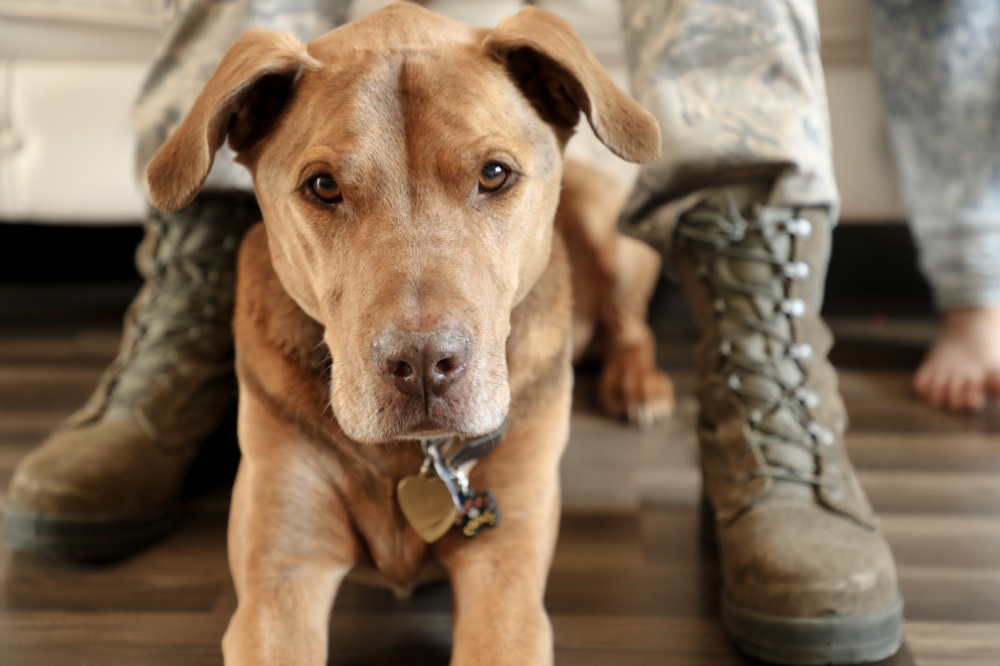
The Guide to Guide Dogs

The month of September provides an opportunity to honor the guide dogs and service dogs that serve our friends and family daily. These working dogs are always there to offer support to their handlers, so we thought it was only fitting that we supported them during this month of recognition.
A common misconception is that a guide dog and a service dog are the same. As we’ll explain further, there are several types of dogs that fit under the term ‘service dogs’, including the guide dog.
Let’s break down the different kinds of service dogs, identify some common breeds, and discuss service dog etiquette.
Types of Service Dogs

A service dog is a canine that’s specially trained to serve individuals with disabilities. These individuals are usually referred to as “handlers”. Depending on what their handler’s disability is, a service dog might be trained to perform up to a dozen tasks.
There are so many types of service dogs; it’s tough to list them all out here! You’ve most likely heard of hearing dogs, diabetic alert dogs, autism assistance dogs, and wheelchair assistance dogs. Additionally, there are various service dogs that are specifically trained to provide assistance or alert others if there is an emergency for their handler.
Another type of service dog that you’ve probably heard of is the guide dog, or “seeing eye dog”. These dogs are trained to support those who are visually impaired. As hearing dogs support the hearing impaired, guide dogs lead their vision-impaired handlers around safely to avoid obstacles.
Common Working Dog Breeds
You’ve most likely noticed that working dogs tend to be Golden Retrievers, Labrador Retrievers, and German Shepherds. There’s definitely a reason why these breeds are popular for service dogs - and a lot of that comes down to size and physical strength. Generally, these large dog breeds are more capable of being a physical extension of their disabled handler as a mobility support dog.
However, service dogs can be of any breed or any size! They do not need to be one of the breeds mentioned above. Handlers may select a certain breed based on specific personality traits or tendencies.

Meet Piper. A Shepherd Terrier mix, she may be smaller than what one may think of when they think of a service dog! At about six months old, she has completed basic training - but still needs to fix her jumping and nipping behaviors. Currently, she is learning how to be out in public places, such as the grocery store.
Once she is one to one and a half years old, Piper can be a certified service dog. She will be trained as a mobility service dog, picking up objects that her handler has dropped, as well as fetching water, medication, or oxygen tubing. Learning to walk on both sides of her handler’s wheelchair will be very important, and she will eventually be introduced to a walker and taught to get help. Piper may be too small to help her pet parent stand up when falling, but there are so many ways she can assist from day to day.
What to Keep in Mind When Around a Working Dog
We know - it’s tough to see an adorable pooch without wanting to pet them! When in doubt though, you should never engage with a working dog without speaking to its handler first. Since these canines are on the job, you’d never want to distract them from supporting their handler. We’ll go over some basic do’s and don’ts for situations that you might encounter out in public.
If you see a working dog, always resist the urge to pet or feed them. If they happen to come to you or engage with you first, politely notify their handler so that they can correct that behavior.
If you have your own pup with you, keep your distance from the working dog. In the best-case scenario, your four-legged friend is a distraction. In the worst-case scenario, there could be a conflict between the two animals.
Suppose a dog with a working vest runs up to you, but you don’t see a handler with them. This may be indicative of an emergency with their handler, and they’re attempting to get your attention. Especially if the dog nudges you, do follow them to see where they take you.
It’s safe to assume that if a working dog is wearing a special harness out in public marked with ‘service dog’, they are on the job. Even if they’re sitting, sleeping, or lying down, refrain from speculating that they are relaxing and off the clock!
How Handlers Can Keep Their Service Dog Comfy
If you’re the handler of a service dog that’s a common breed, keep them comfortable with a nice PupRug™ Faux Fur Orthopedic Dog Bed! These pups work so hard, that they deserve to relax in comfort and style.
Typically, the larger breeds mentioned above are more prone to experiencing joint issues, so a memory foam dog bed can be pressure-relieving as well as supportive. A dog blanket like the PupProtector™ Cool Comfort Waterproof Throw Blanket also offers a cozy spot to unwind.
Now that you know more about service dogs and guide dogs, you’ll know how to react accordingly when seeing one in public. Plus, you can appreciate all that they do not just in September, but all year long!
Share this article
written by


